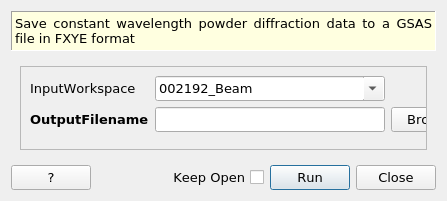\(\renewcommand\AA{\unicode{x212B}}\)
SaveGSSCW v1¶

SaveGSSCW dialog.¶
Summary¶
Save constant wavelength powder diffraction data to a GSAS file in FXYE format
See Also¶
SaveGSS-v1
Properties¶
Name |
Direction |
Type |
Default |
Description |
|---|---|---|---|---|
InputWorkspace |
Input |
Mandatory |
Workspace to save |
|
OutputFilename |
Input |
string |
Mandatory |
Name of the GSAS file to save to. Allowed extensions: [‘.gss’] |
Description¶
Saves a constant wavelength diffraction pattern in units Degrees to FXYE GSAS format.
From the GSAS manual a description of the format options: If TYPE is ‘FXY’ or ‘FXYE’ then the data records give the position, intensity and in the case of ‘FXYE’ the esd in the intensity with one set per record and in free format. The values may also be in scientific form. The position is either in centidegrees for CW data or microseconds for TOF data. Each record must be padded out to 80 characters and end with CR/LF.
Usage¶
Example - a basic example using SaveGSSCW.
import os
# Create a workspace to save
ws = CreateSampleWorkspace(OutputWorkspace="SaveGSSWorkspace", XUnit='Degrees')
ws = ExtractSingleSpectrum(ws, WorkspaceIndex=0)
# Save to the users home directory
file_name = "myworkspace.ascii"
path = os.path.join(os.path.expanduser("~"), file_name)
SaveGSS(ws, path)
# Does the file exist
path = os.path.join(os.path.expanduser("~"), file_name)
print(os.path.isfile(path))
Output:
True
Categories: AlgorithmIndex | DataHandling\Nexus
Source¶
Python: SaveGSSCW.py
